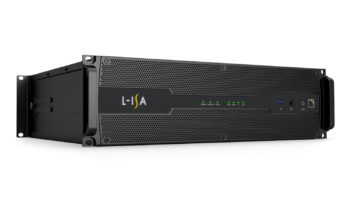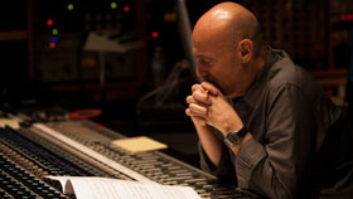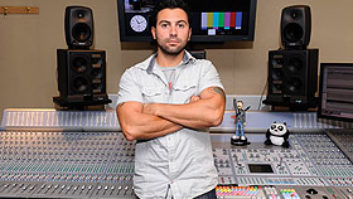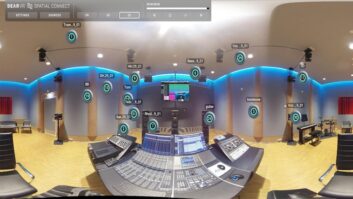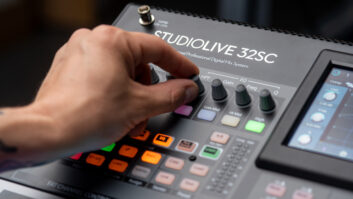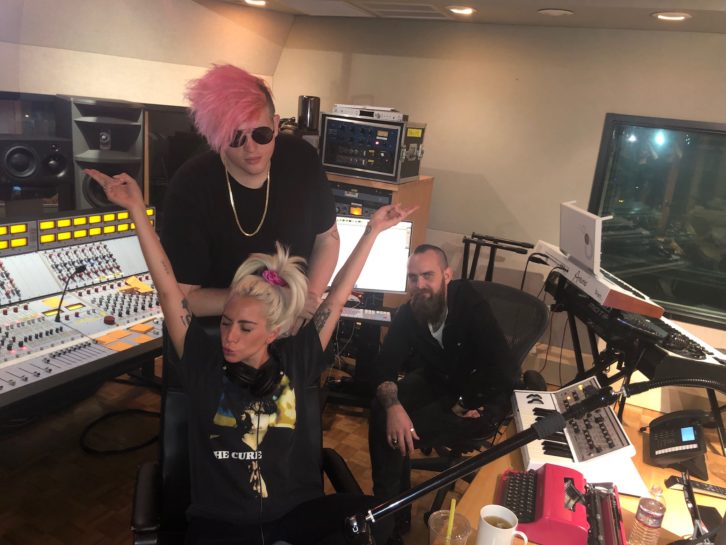
For all her larger-than-life presence, Lady Gaga has a genuine intimacy in her artistry. She takes the personal to the next level on her latest full-length album, Chromatica, where she lays bare her mental health issues, her sexual assault trauma, her masochistic tendencies and her journey toward healing.
Part of this healing process is through dance, and Chromatica is, unapologetically, a dance album. Specifically drawing from ’90s dance, with the euphoric elements of that time and that sound, Chromatica provides a safe space for her acknowledgments and her confessions.
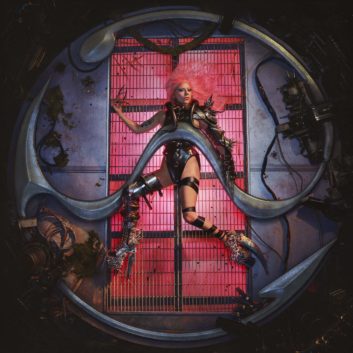 This intimacy gets its start at her state-of-the-art home studio, which once belonged to Frank Zappa. Right alongside her is her vocal producer and mixer of the last seven years, Benjamin Rice. Rice’s working relationship with Gaga began at Record Plant, where the studio’s famed Rose Mann-Cherney placed him as second engineer while Gaga was working on her Artpop album. Rice was with her through all of A Star Is Born and Chromatica.
This intimacy gets its start at her state-of-the-art home studio, which once belonged to Frank Zappa. Right alongside her is her vocal producer and mixer of the last seven years, Benjamin Rice. Rice’s working relationship with Gaga began at Record Plant, where the studio’s famed Rose Mann-Cherney placed him as second engineer while Gaga was working on her Artpop album. Rice was with her through all of A Star Is Born and Chromatica.
“Every song starts the same way,” Rice explains. “We’re at her house, and she’s pouring her heart out to us through tears. All the things she’s dealing with or wants to bring back up or wants to work through, she puts all of her emotion into it. It’s very emotional for us because we have a front seat with her. She’s comfortable to share with us in this close, trusted environment, and that dictates what this song should be about and how she’s going to perform it and what she wants to say.”
Whether at her home studio or at any of the commercial facilities Team Gaga booked for the project—Henson Recording Studios, Los Angeles, in particular—cutting the vocals starts in the control room on headphones with Rice and Gaga side-by-side. “There’s an energy with us sitting in the same room, right next to each other, that makes communication so immediate,” Rice says. “There’s no talkback situation. I give her a thumbs-up. I give her a high-five. We’ll try something, scratch it, try again. We can work it out on the spot.
“She also has her pen and paper as she’s writing lyrics, or her laptop, or her typewriter,” he continues, “There’s something about the team feeling, the cohesiveness of being right next to each other, that you can’t really compare to someone being 30 feet away behind glass on headphones, hearing from a distance. I want her and I to be hearing the exact same thing. If we’re sitting right next to each other, there’s no gap in communication or what we’re shooting for.”
Gaga typically does a 30-minute warm-up and a cooldown. She’ll sing for an hour, performing the song from top to bottom, discussing the character in between each take. This repetition is not for her to “get it right,” but so she can try different ideas, change a lyric, challenge a lyric or add a harmony. Her performance of each song is exactly that, the same as she would if she were in front of an audience, not a line-by-line, section-by-section, vocal take.
Capturing That Unique Voice
Whether in the control room, live room or the iso booth for re-cuts, the vocal chain is vintage Neumann U47 mic into vintage Neve 1073 preamp into Tube-Tech CL 1B compressor. The level of familiarity with this chain and the way she sounds through it allows Gaga to use the technology as something like an instrument. While the only sound that is being printed is what comes through the hardware chain, Rice has an extensive vocal production/mix template of 60-plus tracks.
“Because she’s so unique and so special as a singer, I don’t want to start raw with nothing exciting, start so dry then figure out how to build it later,” Rice explains. “I have several lead tracks that route to a lead bus. Each lead track is processed by around 10-plus plug-ins in a series. I have 10 sends ready for send/return FX processing. I keep several of the sends visible on my edit screen so I can make adjustments as necessary.
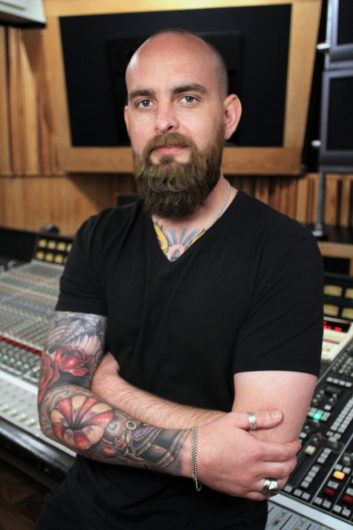
“As I’m cutting and discussing the takes, I mark sections and create comps on the fly, which I then drag to multiple comp tracks that are processed through the lead bus,” he adds. “This allows me to continually build a temporary lead comp, which we use as our reference as we build. I have four or more background vocal buses with a dozen tracks for each bus and separate cut tracks. With these, I can quickly create stacks, doubles or harmonies. All of these background buses are processed differently and separately from the lead bus so that I can create various textures and tones to complement the lead vocal. The vocal buses are routed to an ALL VOX bus so I can process the combination of all vocals.
“For effects processing, I have 12 to 15 internal returns with a variety of reverb combinations and delay stacks that I can access in real time. With this, I can create a texture that fits the song. Each of the returns are also processed with EQ and dynamics tools. For instance, I keep reverbs and EQs post my delays, and vice versa—in bypass mode, so I can adjust the wetness and dynamic nature of each effect. I use around six outboard sends to physical plates and rooms that Henson has available, as well as an Eventide H3500 and an AMS RMX16 effects processor. This way I can combine internal effects with real plates, real rooms and outboard FX processors in order to create an organic sense of space.
“Lastly, I’ve created a dozen ‘Hard FX’ audio tracks that I always keep near my lead tracks. Each of these hard FX tracks have different combinations of three to five plug-ins per track that I keep fully wet and ducked in volume. For instance, hard FX track 1 will be a delay fully wet, going into a modulation plug-in around 20 percent, to a reverb at 15 percent, then to a bit of distortion. The track itself is ducked in volume at -12, and each of the hard FX tracks are routed to a special FX bus that has some dynamic and stereo enhancing processing. I can quickly grab words or phrases to create immediate throws and ear candy, while cutting to help build the sonic texture of the vocal production in unique ways.
“Everything is routed to an ALL FX master bus so I can further control the dynamic nature of all of the FX quickly and easily. That way I can make quick adjustments to how the overall dry vocals and wet returns interact with each other. It is a lot of routing, but it gives me tons of flexibility and control.”
A Variety of Vocals
Once Rice is set up in one of the commercial studios, he and Bloodpop, the overarching producer for Chromatica, work in separate own rooms, but in close proximity, tag-teaming each other with instrumentals and a cappella flourishes, and influencing each other’s production decisions. During this phase, Rice’s focus is on extracting the best vocal performances from various locations and sessions, comping and further processing them to create the character that embodies the emotion of the song.
He stems down the vocal mixes, prints them, keeps the pieces, compiling everything to make new and different sounds. This way, if new vocals are cut, he can combine old stems using, say, reverb prints from a year ago as an effect from an early vocal session so that they are entirely different than the reverbs heard on the vocals cut at a later date. With Chromatica being in production from February 2018 to February 2020, Rice ended up with endless numbers of these stemmed effects from which he can draw from at will.
“The song ‘Enigma,’ in the post-chorus, there’s a lot of swimming delay throws and distorted vocals in the background that don’t melodically match what she’s doing in the lead,” says Rice. “Those are demo takes I’ve mixed and treated specifically for that sound that I kept in the mix, so when she’s singing the main melody, the main effects go in a different direction. It’s a mixture of things I’d mixed and produced from previous sessions that gave it more dynamics, variation and change.
“It always feels fresh and different, as opposed to delays and reverbs and production tricks based off the lead that you hear at the moment,” he adds. “If I pitched vocals, if I made harmonies and ran those through processors, I would have those printed so I could always be playing how I mix those into the re-takes. It was an ongoing thing. I would have writing sessions, working sessions, final production sessions, re-cutting sessions, my print sessions, my final touch-up sessions and the stem sessions.”
Rice applies these same production techniques to Chromatica’s vocal collaborators: Ariana Grande, Elton John and Blackpink. Grande was in the studio with Rice for her vocal recording, Sir Elton did his vocals with Rice from London over Skype, and Blackpink sent theirs to him. “Rain on Me,” the song with Grande, is an example of countless versions, which Rice printed and kept, molding the pieces into the what is heard on the final version.
Producing and mixing talents aside, organization is one of the main factors in managing the vocals. Says Rice, “When you’re making a record in real time that’s a moving target, it’s so important that you’re keeping up with it and organizing it in a way that you can constantly be a step ahead of where everyone else is. Gaga can ask me, ‘What did it sound like the first time?’ That may have been 30 sessions ago, but I can have it ready on the spot to show her. If we change the tempo or the key, I have to go back and manipulate those vocals to fit.
“After all these years of working together, I understand what she wants to hear, but I also understand what is the best and moves me the most,” he continues. “We talk a lot artistically about the comps, and she trusts me to make those decisions. If I play it for her and she cries, I know I’ve done my job.”
Mixing the Music
In the same way that Rice is in charge of the vocal mixing, Tom Norris—brought onboard by Bloodpop—is in charge of mixing the music. Norris, who got his start posting cheeky remixes of popular songs on SoundCloud under the moniker “getyoursnackon,” is a heavy hitter in the dance scene, having mixed Illenium’s Ascend, as well as working closely with Skrillex and Zedd. Norris proved a particularly good choice, as Chromatica’s musical happy place is the underground dance clubs of the ’90s, with which Norris is personally connected.
When calling on Norris for mixing, it’s understood that he also does production adds at that stage. For Chromatica, his role was finalizing. Norris set up shop at Henson’s Studio Mix, and while he is comfortable working on every DAW, he falls back on Ableton if given a choice. With Henson’s SSL 6072E/G at his disposal, he started using the board’s compressor, then opted for a stand-alone rack.
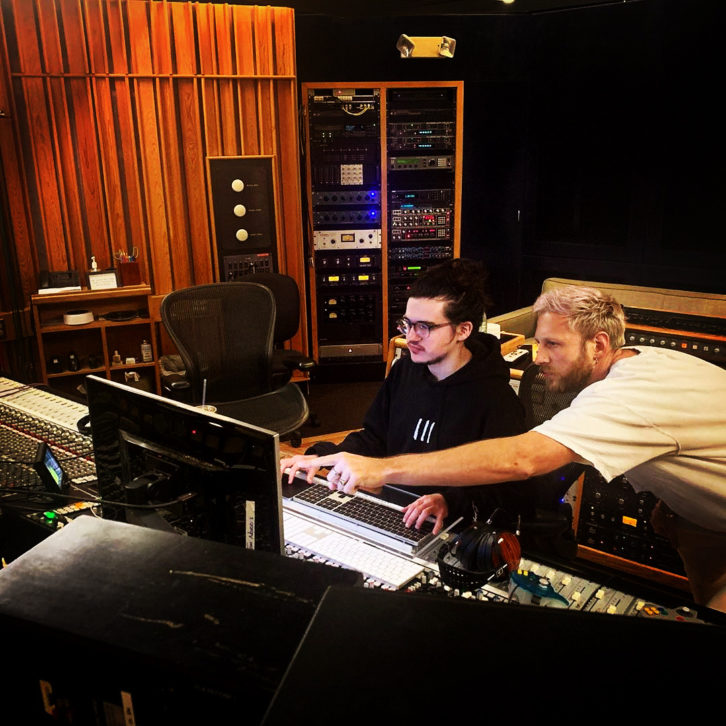
“The sound of hardware is just different to me than what I’m used to using,” Norris says. “For Chromatica, the different factor was good because it is definitely an homage to records that were made with hardware decades ago. I was forbidden to use sidechain on any of the songs. I mostly relied on the SSL G Compressor on the master, turning up the kick drum into that, the sort of sound you hear on French touch records. I brought in my Alesis 3630 compressor, which is a total piece of crap, but it really has a sound to it. It’s this $50 compressor that they use in churches. It was used on at least the first two Daft Punk records. That made its way into the more melodic pieces of songs like ‘Rain on Me,’ which has a ‘Stardust’ vibe.”
Hearing Elton John’s vocals on a song that ends in an LTJ Bukem-like drum ‘n’ bass meltdown can be traced back to Norris, as can the warbles of Inphonik RX950 Classic AD/DA converter on “Babylon,” mimicking the sound of the Akai S950 on 808 State’s “Pacific State.” Norris brings these classic sounds of the underground—which never made it overground, even at the height of their popularity—to the current pop landscape in his crafted mix.
“There is a duality here where we wanted to make Chromatica the most authentic modern tribute to that era of music and get the details right. At the same time, these are pop records,” says Norris. “To have ‘Rain on Me’ against a DaBaby record is a bit of an outlier. That was definitely something I was thinking about, how dance should this be, because it’s also a pop album, so the vocals need to sit up front. That’s the only thing a lot of people hear, and that’s just the reality of it. Also, it’s easy to do that because Gaga has such a commanding performance in everything she does, and the vocals are so amazingly recorded and well done.”
Says Rice, in summation: “It was nice to focus on my skill set as the sonic designer for vocals and for [Norris] to focus on his skill set as the sonic designer for the music. No matter how crazy my vocal sessions were, because I wasn’t having to send it to someone else to pull up in the studio, I could make it sound exactly how I wanted with a thousand plugs, hardware inserts, outboard. [Tom Norris] is a master of dance recording mixing, and we could go back and forth until it felt great.”
